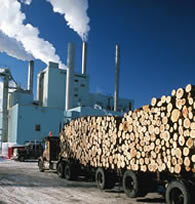Clean sheet for paper making

New catalyst could bring cleaner paper. <br>© Corbis
New catalyst means greener paper is not pulp fiction.
Pollution from paper production could be cut, say US chemists, with a new way of refining wood pulp1. But the process must go through the mill before it can convert industry.
During paper production, gluey wood component lignin is stripped out to leave stringy cellulose. The harsh chemicals used create environmental pollutants, such as toxic and long-lasting chlorinated compounds.
A new chemical catalyst makes harmless gas oxygen do the same job, Craig Hill of Emory University in Atlanta, Georgia and his colleagues have shown. “It’s set up for being green chemistry,” says joint team leader Ira Weinstock of the US Department of Agriculture Forest Service in Madison, Wisconsin.
“It’s a noble effort,” says industrial chemist William Kruper of the Dow Chemical Company in Midland, Michigan. But unless the catalyst’s efficiency is improved, “the industry isn’t going to adopt this technology tomorrow”, he warns.
Waste paper
Paper manufacturing is one of the world’s largest industries. It generates 100 million tonnes of wood pulp a year. Using strong chemicals and high temperatures, pulping digests up to 90% of the lignin from wood chips. The resulting slurry is made into low-quality paper such as brown grocery bags.
For premium white paper, pulp is bleached and the remaining lignin is degraded using chlorine or the more environmentally friendly substitute, chlorine dioxide. These chemicals selectively break down lignin rather than cellulose by stealing its electrons, in an ’oxidation’ reaction. The new catalyst replaces this step.
The catalyst – called a polyoxometalate (POM) – was inspired by a protein in wood-digesting fungi. First, POM oxidizes lignin. Then oxygen re-oxidizes POM. This second step converts lignin to harmless carbon dioxide and water and recycles the catalyst.
At the end of the process, the catalyst must be carefully removed to avoid traces ending up in the paper. POM contains the heavy metals tungsten and molybdenum, also of concern to environmentalists.
Although this is “clever chemistry”, says Terry Collins of Carnegie Mellon University in Pittsburgh, Pennsylvania, “it’s important that people keep experimenting with alternative technologies”.
The inefficiency of the reaction means that 170 tonnes of catalyst are needed for every tonne of wood pulp, points out Collins, who works on green chemistry. This ratio would make working with the catalyst an expensive operation. He feels that new processes should aim to be cheap, efficient and non-toxic.
Weinstock argues that these criteria can be met and that the process can be made economically competitive.
References
- Weinstock, I. A. et al. Equilibriating metal-oxide cluster ensembles for oxidation reactions using oxygen in water. Nature, 414, 191 – 195, (2001).
Media Contact
More Information:
http://www.nature.com/nsu/011108/011108-9.htmlAll latest news from the category: Ecology, The Environment and Conservation
This complex theme deals primarily with interactions between organisms and the environmental factors that impact them, but to a greater extent between individual inanimate environmental factors.
innovations-report offers informative reports and articles on topics such as climate protection, landscape conservation, ecological systems, wildlife and nature parks and ecosystem efficiency and balance.
Newest articles
Faster, more energy-efficient way to manufacture an industrially important chemical
Zirconium combined with silicon nitride enhances the conversion of propane — present in natural gas — needed to create in-demand plastic, polypropylene. Polypropylene is a common type of plastic found…

Energy planning in Ghana as a role model for the world
Improving the resilience of energy systems in the Global South. What criteria should we use to better plan for resilient energy systems? How do socio-economic, technical and climate change related…

Artificial blood vessels could improve heart bypass outcomes
Artificial blood vessels could improve heart bypass outcomes. 3D-printed blood vessels, which closely mimic the properties of human veins, could transform the treatment of cardiovascular diseases. Strong, flexible, gel-like tubes…





















